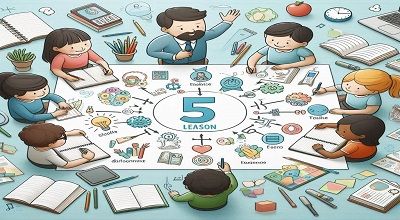5E Model of Teaching
The 5E Model of Teaching is an instructional framework that involves five phases: Engage, Explore, Explain, Elaborate, and Evaluate. This model is widely used in science education but can be adapted for various subjects.
Below is a sample lesson plan using the 5E Model of Teaching:
- Subject: Science
- Grade Level: 6
- Topic: The Water Cycle
Engage (10 minutes)
- Objective: Introduce the concept of the water cycle and engage students in thinking about what they already know.
Activity
- Show a short video or an animation illustrating the water cycle.
- Ask open-ended questions to provoke thoughts, such as: “What happens to rain after it falls?” “Where does water go when it evaporates?”
- Encourage students to share their ideas in a class discussion.
Explore (20 minutes)
- Objective: Allow students to explore the water cycle through hands-on activities and observations.
Activity
- Provide each student/group with a small tray, a cup of water, a lamp, and plastic wrap.
- Instruct them to set up a mini water cycle model using the materials. Ask them to make predictions about what will happen.
- While students are working, circulate and ask guiding questions like, “What do you observe?” “What changes are occurring?”
Explain (15 minutes)
- Objective: Introduce key concepts and explanations related to the water cycle.
Activity
- Discuss the observations made during the exploration phase as a class.
- Use visual aids, diagrams, and charts to explain the different stages of the water cycle (evaporation, condensation, precipitation).
- Clarify any misconceptions and ensure understanding before moving on.
Elaborate (20 minutes)
- Objective: Allow students to deepen their understanding through more complex activities.
Activity
- Provide additional resources like articles, videos, or interactive simulations for students to explore the water cycle in more detail.
- Have students create a diagram or poster illustrating the water cycle stages and present it to the class.
- Facilitate a class discussion on the importance of the water cycle in maintaining the Earth’s ecosystems.
Evaluate (15 minutes)
- Objective: Assess students’ understanding of the water cycle.
Activity
- Assign a short quiz or worksheet that includes questions related to the water cycle.
- Review the posters/diagrams created by students for accuracy and completeness.
- Conclude with a class discussion, allowing students to share what they’ve learned.
Homework/Extension (Optional)
- Assign additional reading or a project related to the water cycle for further exploration.
- Encourage students to observe the water cycle in their everyday lives and report back with findings.
- This lesson plan is flexible and can be adjusted based on the specific needs of your students and the available resources.
